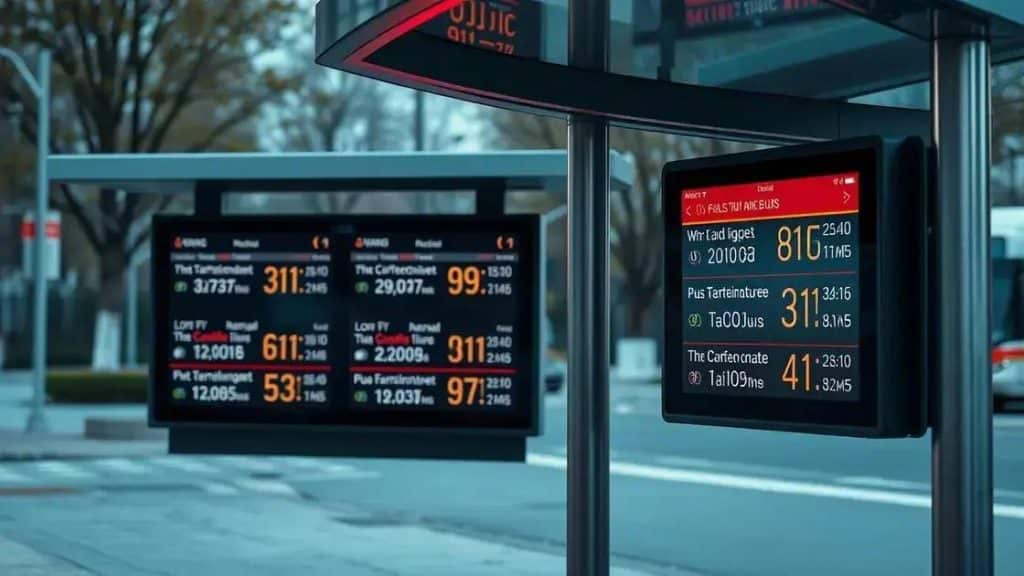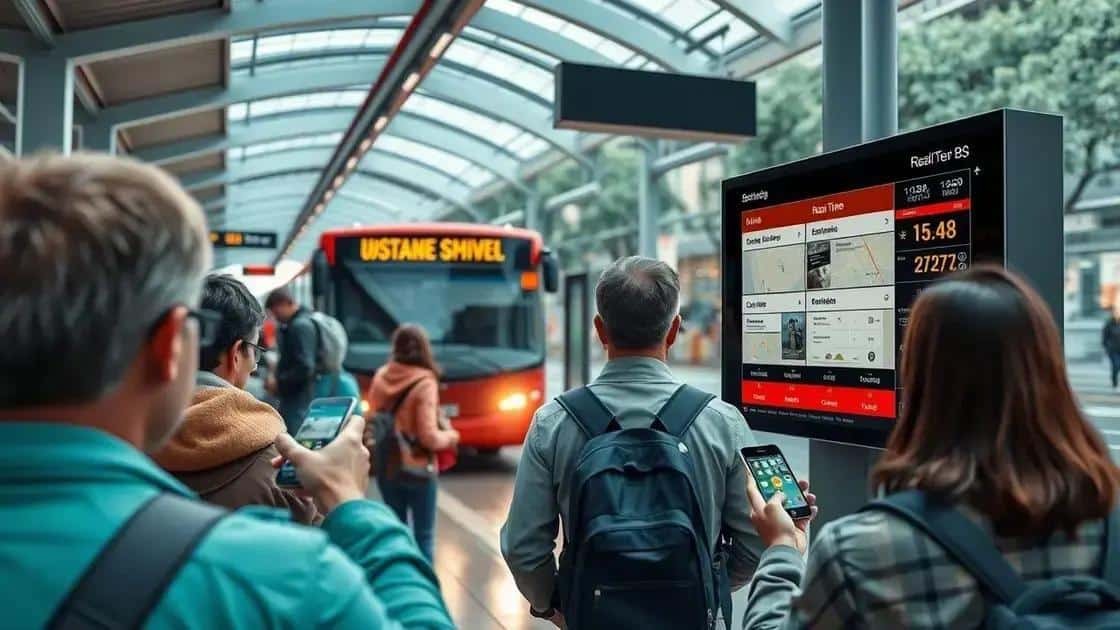Real-time passenger information systems for buses: stay updated

Real-time passenger information systems for buses provide live updates on schedules, enhancing commuter experience by reducing wait times and improving overall transit efficiency.
Real-time passenger information systems for buses are transforming the way we navigate public transport. Have you ever waited at a bus stop, unsure if your ride was delayed? These systems aim to eliminate that uncertainty and keep commuters informed. Let’s explore how they work and their impact on everyday travel.
Understanding real-time passenger information systems
Understanding real-time passenger information systems is crucial in modern transportation. These technologies provide essential updates to commuters, enhancing their travel experience. By offering timely information about bus schedules, arrival times, and delays, they enable passengers to make informed decisions.
The systems rely on various technologies to gather and distribute data effectively. For instance, GPS tracking on buses allows for accurate location updates. This technology connects with digital displays at bus stops and mobile applications, ensuring passengers receive real-time data.
How do they work?
Real-time systems utilize a combination of sensors, data analytics, and communication technologies. Here are some key components:
- GPS tracking devices on buses
- Data processing centers that analyze information
- Mobile apps that notify users
- Digital display boards at stations
These elements work together seamlessly. When a bus approaches a stop, data is collected and transmitted quickly. Thus, users can see whether their bus is on time or delayed. This real-time feedback reduces anxiety and improves overall satisfaction.
Benefits of real-time information
The advantages of implementing these systems extend beyond convenience. Improved passenger information leads to better management of transport resources. For example, transit authorities can analyze data trends to optimize bus routes and schedules. In turn, this can increase efficiency and reduce costs.
Additionally, real-time updates contribute to safer travel experiences. Passengers can avoid waiting in unsafe or uncomfortable conditions by knowing when their bus will arrive. As a result, they feel more at ease when using public transport.
Overall, real-time passenger information systems represent a leap forward in public transport technology, merging convenience and safety. The blend of technology and user experience makes commuting less stressful and more efficient.
How these systems enhance the public transport experience

How these systems enhance the public transport experience is a vital aspect of modern transit solutions. Real-time passenger information systems provide crucial updates that transform how we use public transport. By knowing exactly when their bus will arrive, passengers can plan their journeys better and reduce wait times.
The growing integration of technology not only benefits commuters but also transport authorities. For instance, when users can access live updates, the overall system becomes more efficient. This leads to fewer delays and improved service quality.
Key improvements in public transport
Several key areas illustrate how these systems enhance the public transport experience:
- Enhanced commuter satisfaction through timely updates.
- Reduced perceived wait times with accurate arrival data.
- Better resource allocation for transport agencies.
- Increased safety for passengers waiting at bus stops.
A major advantage of knowing bus arrival times is the reduction of uncertainty. For example, if a bus is delayed, passengers can find alternative transportation options without unnecessary stress. This convenience leads to a more pleasant commuting experience and encourages more people to use public transport.
Moreover, the data collected from these systems helps transit agencies analyze patterns and improve routes. It allows them to identify peak times, adjust schedules, and allocate buses effectively. These improvements can lead to fewer overcrowded buses and better overall service.
When passengers feel valued and informed, their willingness to use public transport increases. It’s essential for cities to embrace these technologies not only to enhance the experience but also to foster a culture of public transport use.
Challenges faced in implementing real-time systems
Challenges faced in implementing real-time systems are significant hurdles that cities encounter when enhancing public transportation. While the benefits are clear, the journey toward implementing real-time passenger information systems can be complex. Understanding these challenges is critical for successful execution.
One major challenge is the cost associated with technology upgrades. Implementing real-time systems often requires extensive investment in new equipment, software, and maintenance. Transit authorities must find funding and justify these costs to stakeholders who may not see the immediate return on investment.
Technical hurdles
Another challenge lies in the technical aspects of system integration. Real-time data relies heavily on accurate GPS tracking, reliable internet connectivity, and data management systems. If any of these components fail, it could lead to inaccurate information being displayed. This directly affects passenger trust and can discourage the use of public transportation.
- Ensuring compatibility with existing infrastructure.
- Training staff to effectively manage new technology.
- Maintaining data privacy and security for users.
- Addressing potential software bugs and outages.
Additionally, another concern is the challenge of public perception. Some passengers may have a hard time trusting technology, particularly older generations who are used to traditional transit methods. Effective communication strategies are vital to educate the public on how these systems work and their advantages.
Furthermore, transit agencies face the ongoing challenge of changing urban demands. Cities are continually evolving, and public transport systems must adapt to new neighborhoods and population shifts. This need for constant updates can strain resources and complicate long-term planning.
Understanding these challenges is essential for municipalities aiming to improve their public transport services. Recognizing potential obstacles allows for better strategic planning and increases the chances for successful implementation of real-time passenger information systems.
Future trends in passenger information technology

Future trends in passenger information technology are shaping the way we think about public transportation. As cities grow and technology advances, these systems are becoming more sophisticated, paving the way for exciting innovations. Understanding these trends is essential for both commuters and transit authorities.
One major trend is the rise of mobile applications. These apps offer real-time updates and personalized notifications directly to users. Passengers can receive alerts about arrivals, delays, and any changes to their routes. This immediate access to information empowers users and enhances their overall travel experience.
Integration with smart cities
Another significant trend is the integration of passenger information systems with smart city frameworks. By connecting with other urban data, these systems can provide a comprehensive view of transportation. For instance, traffic data can be analyzed alongside public transport information to optimize routes and schedules. Additionally, smart traffic lights can adjust signal timings based on real-time bus locations, helping to reduce delays.
- Improved accessibility features for users with disabilities.
- Enhanced data analytics for transit authorities.
- Use of AI to predict passenger demand.
- Integration of sustainable transport options, such as bike-sharing.
Furthermore, as technology like artificial intelligence (AI) evolves, we can expect enhanced predictive capabilities. AI can analyze historical data and patterns to forecast busy times. This means transit systems can adjust services to meet demand, ensuring buses are where they are needed most.
Moreover, sustainability trends are also impacting passenger information technology. With a global focus on reducing carbon footprints, many transit systems are exploring greener solutions. Innovations in renewable energy and electric vehicles are being integrated into existing infrastructures, leading to environmentally-friendly public transport options.
These advancements represent just the beginning of a transformative journey in public transportation. As passenger information technology continues to evolve, the experience for commuters will become more dynamic and personalized than ever before.
FAQ – Frequently Asked Questions About Real-Time Passenger Information Systems
What are real-time passenger information systems?
These systems provide live updates about public transport schedules, arrival times, and delays, enhancing the commuter experience.
How do these systems improve public transportation efficiency?
They optimize routes and schedules based on real-time data, which helps reduce delays and improves service quality.
What challenges do cities face when implementing these systems?
Cities may encounter high costs, technical hurdles, and public perception issues that can impact the successful implementation of these technologies.
What future trends are expected in passenger information technology?
Future trends include the integration of AI for predictive analytics, mobile applications for personalized updates, and smart city integrations.





